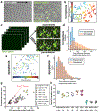Ferroptosis occurs through an osmotic mechanism and propagates independently of cell rupture
- PMID: 32868903
- PMCID: PMC7644276
- DOI: 10.1038/s41556-020-0565-1
Ferroptosis occurs through an osmotic mechanism and propagates independently of cell rupture
Abstract
Ferroptosis is a regulated form of necrotic cell death that is caused by the accumulation of oxidized phospholipids, leading to membrane damage and cell lysis1,2. Although other types of necrotic death such as pyroptosis and necroptosis are mediated by active mechanisms of execution3-6, ferroptosis is thought to result from the accumulation of unrepaired cell damage1. Previous studies have suggested that ferroptosis has the ability to spread through cell populations in a wave-like manner, resulting in a distinct spatiotemporal pattern of cell death7,8. Here we investigate the mechanism of ferroptosis execution and discover that ferroptotic cell rupture is mediated by plasma membrane pores, similarly to cell lysis in pyroptosis and necroptosis3,4. We further find that intercellular propagation of death occurs following treatment with some ferroptosis-inducing agents, including erastin2,9 and C' dot nanoparticles8, but not upon direct inhibition of the ferroptosis-inhibiting enzyme glutathione peroxidase 4 (GPX4)10. Propagation of a ferroptosis-inducing signal occurs upstream of cell rupture and involves the spreading of a cell swelling effect through cell populations in a lipid peroxide- and iron-dependent manner.
Conflict of interest statement
Competing Interests
Memorial Sloan-Kettering Cancer Center and three investigators involved in this study (M.S.B., U.W., and M.O.) have financial interests in Elucida Oncology, Inc. Research involving C’ dots may involve one or more U.S. or international patent applications.
Figures






Comment in
-
Igniting the spread of ferroptotic cell death.Nat Cell Biol. 2020 Sep;22(9):1027-1029. doi: 10.1038/s41556-020-0570-4. Nat Cell Biol. 2020. PMID: 32868901 No abstract available.
References
-
- Fink SL & Cookson BT Caspase-1-dependent pore formation during pyroptosis leads to osmotic lysis of infected host macrophages. Cell Microbiol 8, 1812–1825 (2006). - PubMed
-
- Degterev A et al. Chemical inhibitor of nonapoptotic cell death with therapeutic potential for ischemic brain injury. Nat Chem Biol 1, 112–119 (2005). - PubMed
Publication types
MeSH terms
Substances
Grants and funding
LinkOut - more resources
Full Text Sources

